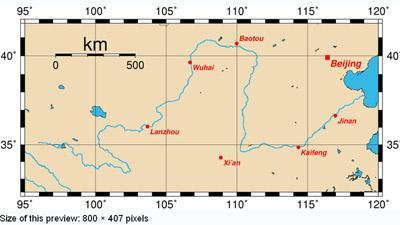Yellow River, is the second-longest river in China
2009-11-20 14:56 BJT
The Yellow River or Huang He is the second-longest river in China (after the Yangtze River) and the sixth-longest in the world at 5,464 kilometers (3,398 mi). Originating in the Bayan Har Mountains in Qinghai Province in western China, it flows through nine provinces of China and empties into the Bohai Sea. The Yellow River basin has an east-west extent of 1900 km (1,180 mi) and a north-south extent of 1100 km (684 mi). Total basin area is 742,443 km² (290,520 mi²).
 |
| Course of the Yellow River with major cities |
The Yellow River is called "the cradle of Chinese civilization", as its basin is the birthplace of the northern Chinese civilizations and was the most prosperous region in early Chinese history. But frequent devastating flooding largely due to the elevated river bed in its lower course, has also earned it the unenviable name "China's Sorrow".
Early Chinese literature refers to the Yellow River simply as He (河), or "River". The first appearance of the name "Yellow River" (黃河) is in the Book of Han (Chinese: 漢書; pinyin: Hàn Shū) written in the Western Han dynasty (206 BC–AD 9). The name "Yellow River" describes the perennial ochre-yellow colour of the muddy water in the lower course of the river. The yellow color comes from loess suspended in the water.
Sometimes the Yellow River is poetically called the "Muddy Flow" (Chinese: 濁流; pinyin: Zhuó Liú). The Chinese expression "when the Yellow River flows clear" is similar to the English expression "when pigs fly."
Editor: Zheng Limin | Source: wikipedia
 Mail
Mail Share
Share Print
Print


 Video
Video









 2009 China Central Television. All Rights Reserved
2009 China Central Television. All Rights Reserved